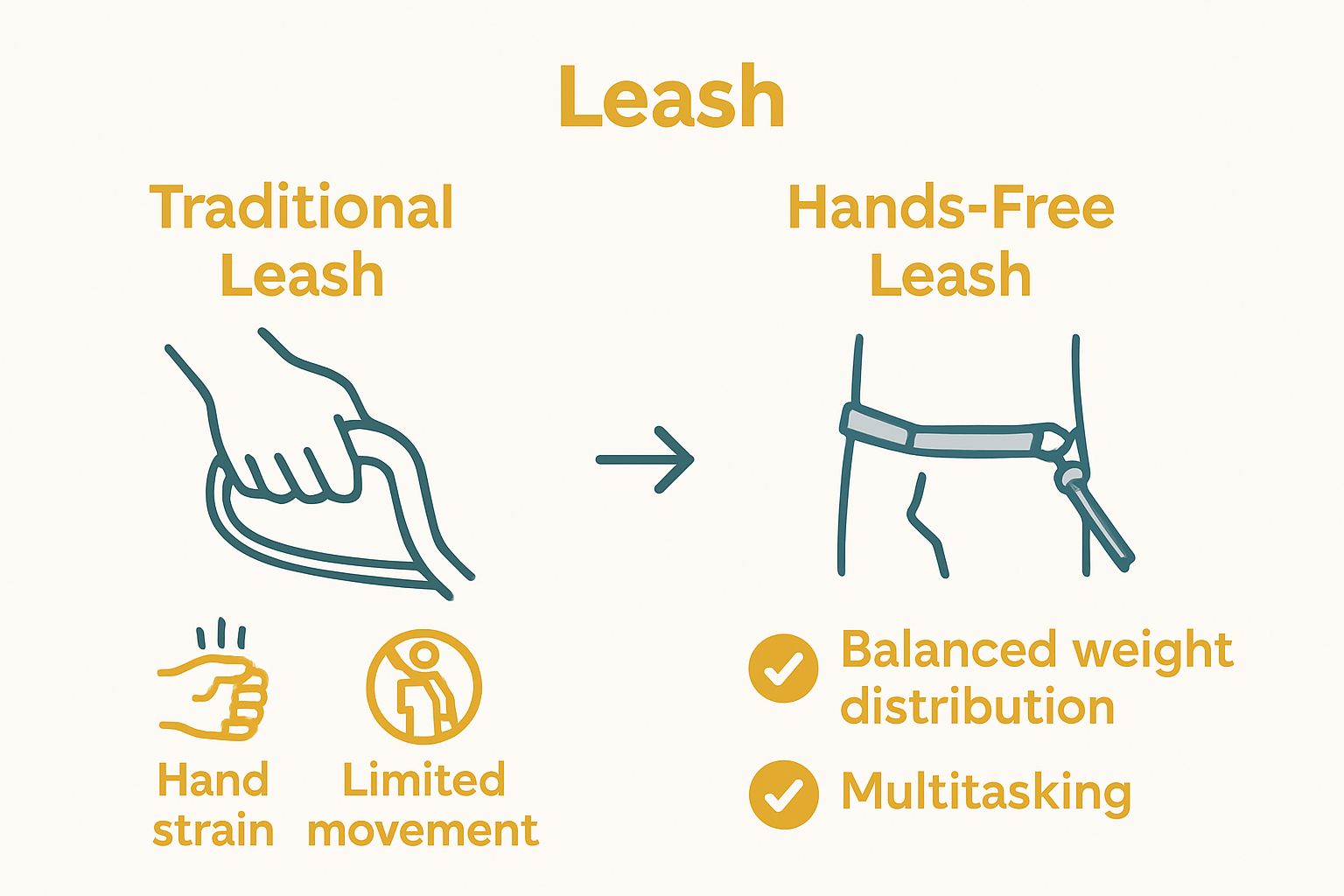Hands-free leashes are changing the way people walk their dogs. These clever systems let you run, hike, or juggle groceries all while staying connected to your dog. Here is something surprising: using a hands-free leash can reduce upper body strain by spreading your dog’s weight across your core for better comfort and control. Most people expect these leashes to be risky or clumsy, but they actually give you smoother walks and closer communication with your dog for a more enjoyable outing every time.
Table of Contents
- What Is A Hands-Free Leash?
- The Benefits Of Using A Hands-Free Leash
- How Hands-Free Leashes Improve Dog Walking Experiences
- Key Features To Look For In Hands-Free Leashes
Quick Summary
| Takeaway | Explanation |
|---|---|
| Hands-free leashes enhance mobility | They allow dog owners to manage tasks without compromising control during walks or runs. |
| Improves physical comfort for owners | Reduces strain on the upper body by distributing the dog’s weight across the core. |
| Promotes better training communication | Enables more nuanced training cues and behavior correction while walking. |
| Increases safety and control | Designed for stable tension management, reducing sudden movements that may startle dogs. |
| Select durable, ergonomic leashes | Prioritize materials and comfort features to ensure effective and safe use during walks. |
What is a Hands-Free Leash?
A hands-free leash represents an innovative dog walking solution that allows pet owners to move freely while maintaining secure control over their canine companion. Unlike traditional leashes that require constant manual gripping, these specialized accessories attach around the owner’s waist or across the body, providing a unique method of dog management during walks, runs, and outdoor activities.
Design and Functionality
Hands-free leashes typically feature a sturdy belt or adjustable strap system that connects directly to a dog’s harness or collar. The leash itself is usually made from durable materials like nylon or reinforced polyester, with elastic components that absorb sudden pulling or movement. Read more about different dog walking accessories can help you understand the broader context of modern pet mobility solutions.
The core design incorporates several key components:
- A padded waist belt for owner comfort
- An adjustable leash length mechanism
- Strong attachment points with robust clasps
- Shock-absorbing sections to reduce strain
Practical Applications
These innovative leashes shine in scenarios demanding multitasking or physical activities. Runners, hikers, and active dog owners find them particularly useful because they allow hands-free movement while maintaining control. Whether you are jogging through a park, walking while carrying groceries, or managing other tasks, a hands-free leash provides unprecedented flexibility.
According to veterinary mobility research, hands-free leashes can also help reduce physical strain on both the owner and the dog by distributing tension more evenly and preventing sudden jerking movements that might cause injury. The ergonomic design supports a more natural walking experience, promoting better communication and connection between pet and owner during outdoor activities.
The Benefits of Using a Hands-Free Leash
Hands-free leashes offer dog owners a revolutionary approach to pet mobility that transcends traditional walking methods. By eliminating the need for constant manual grip, these innovative accessories provide numerous advantages that enhance both the owner’s and dog’s walking experience. Learn more about choosing the right dog accessories to complement your hands-free leash strategy.
Enhanced Physical Comfort and Mobility
One of the primary benefits of hands-free leashes is the significant reduction in physical strain. Traditional leashes require constant arm tension and grip, which can lead to wrist, shoulder, and arm fatigue. Hands-free designs distribute the dog’s weight across the owner’s core, providing a more ergonomic and comfortable walking experience.

Key physical advantages include:
- Reduced upper body strain
- Better weight distribution
- Improved walking posture
- Increased walking and running comfort
Multitasking and Freedom of Movement
For active individuals, hands-free leashes represent a game-changing solution. These leashes enable owners to simultaneously manage other tasks while walking their dogs. Joggers can maintain their running rhythm, hikers can use trekking poles, and urban dwellers can carry groceries or manage mobile devices without compromising their dog’s safety.
According to biomechanical research from sports medicine journals, hands-free leashes can improve overall physical activity engagement by reducing the mechanical limitations of traditional leash walking. The design promotes a more natural, fluid movement that benefits both the human and canine participants.
Improved Training and Communication
Hands-free leashes are not just about convenience they also support more nuanced dog training techniques. By keeping tension more consistent and allowing for smoother communication, these leashes help establish better walking discipline. The fixed position around the owner’s waist creates a more stable connection, enabling more effective behavior correction and positive reinforcement during walks.
How Hands-Free Leashes Improve Dog Walking Experiences
Hands-free leashes transform traditional dog walking from a physically demanding task into an enjoyable, interactive experience that strengthens the bond between dogs and their owners. By reimagining how we connect with our canine companions during outdoor activities, these innovative accessories create more dynamic and enjoyable mobility experiences. Learn more about effective dog walking techniques to complement your hands-free approach.
Enhanced Interaction and Connection
Traditional leash walking often creates physical barriers between dogs and owners, with constant tension and manual grip limiting natural communication. Hands-free leashes eliminate these constraints, allowing for more intuitive and responsive interactions. The waist-attached design enables owners to use body language, subtle movements, and verbal cues more effectively, creating a more synchronized walking experience.
Key interaction benefits include:
- More natural communication signals
- Reduced physical tension between dog and owner
- Increased ability to use non-verbal training techniques
- Better overall walking synchronization
Mental and Physical Stimulation
Hands-free leashes provide unique opportunities for mental and physical engagement. Active owners can now seamlessly integrate dog walking with other activities like jogging, hiking, or running errands. This versatility means dogs receive more consistent exercise and stimulation, which is crucial for their overall well-being.
According to canine behavior research, consistent and varied physical activity contributes significantly to a dog’s mental health and reduces potential behavioral issues stemming from insufficient exercise or monotonous walking routines.
Safety and Control Improvement
Contrary to initial concerns, hands-free leashes can actually enhance safety and control. The fixed positioning around the owner’s core provides more stable tension management, reducing sudden jerking movements that might startle or potentially injure the dog. The distributed weight and consistent connection allow for quicker response times and more predictable walking patterns, ultimately creating a more secure walking environment for both dog and owner.

Key Features to Look for in Hands-Free Leashes
Selecting the right hands-free leash requires careful consideration of multiple factors that ensure safety, comfort, and functionality for both dog and owner. Understanding these critical features will help you make an informed decision that enhances your walking experience. Learn more about selecting the right dog walking equipment to complement your hands-free leash selection.
Material and Durability Considerations
The quality of materials directly impacts the leash’s performance, longevity, and overall reliability. High-quality hands-free leashes typically utilize strong, weather-resistant materials that can withstand varying environmental conditions and different dog sizes. Nylon webbing, reinforced polyester, and specialized elastic components provide the necessary strength and flexibility for different walking scenarios.
Key material attributes include:
- High tensile strength
- Resistance to wear and tear
- Quick-drying properties
- UV and moisture resistance
- Lightweight design
Ergonomic Design and Comfort Features
Ergonomic design plays a crucial role in hands-free leash effectiveness. The waist belt must distribute weight evenly, prevent chafing, and provide sufficient padding to ensure owner comfort during extended walks. Adjustable components are essential, allowing customization for different body types and dog sizes.
According to veterinary biomechanics research, proper weight distribution and ergonomic design can significantly reduce physical strain and improve overall walking experience for both dog and owner.
Safety and Control Mechanisms
Safety features are paramount when selecting a hands-free leash. Look for designs with robust attachment mechanisms, quick-release clasps, and reflective elements for increased visibility during low-light conditions. Shock-absorbing sections help manage unexpected dog movements, while multiple attachment points provide flexibility in different walking environments.
Additionally, some advanced hands-free leashes incorporate features like built-in training handles, emergency braking systems, and modular designs that allow for versatile usage across various outdoor activities.
The table below summarizes the key features to consider when selecting a hands-free leash and explains the benefits of each feature.
| Feature | Description | Why It Matters |
|---|---|---|
| Material Durability | Made from strong nylon, reinforced polyester, or elastic | Ensures longevity and withstands pulling |
| Ergonomic Waist Belt | Padded, adjustable, and designed to fit various body types | Enhances comfort during long walks |
| Shock-Absorbing Sections | Elastic components that absorb sudden movements | Reduces strain and risk of injury |
| Robust Attachment Mechanisms | Secure clasps and multiple attachment points | Provides reliable security for different dogs |
| Reflective Elements | Built-in reflective strips or stitching | Increases visibility in low-light conditions |
| Adjustable Leash Length | Mechanism to shorten or lengthen the leash as needed | Offers flexibility for different environments |
| Quick-Release Mechanisms | Easy-to-use release for emergencies or easy removal | Improves safety and convenience |
Ready for Stress-Free Walks and Happier Dogs?
Are you frustrated by the constant tugging and arm fatigue that come with traditional leashes? The article explained how hands-free leashes can transform your daily routine by reducing upper body strain, giving you more freedom of movement, and improving the connection with your furry friend. Imagine walking, running, or multitasking with your dog and feeling completely in sync. That sense of effortless control and comfort is within your reach.

Make your next walk easier and more enjoyable with reliable and stylish hands-free solutions from Wuffinity.store. Browse our expertly curated collection of dog accessories and experience first-hand the difference a quality leash can make. Shop now to take advantage of our latest arrivals and promotions, and see the change in both your comfort and your dog’s happiness. Visit Wuffinity.store and start your stress-free adventure today.
Frequently Asked Questions
What is a hands-free leash and how does it work?
A hands-free leash is a dog walking accessory that attaches around the owner’s waist or across the body, allowing them to move freely while maintaining control over their dog. It typically includes a sturdy belt or strap and connects directly to the dog’s harness or collar.
What are the benefits of using a hands-free leash?
Hands-free leashes reduce physical strain on the owner, enhance mobility, and improve multitasking ability. They allow for more comfortable walking and running, better communication with the dog, and can contribute to improved training outcomes.
How does a hands-free leash improve dog training?
A hands-free leash allows for better control and tension management, which supports more effective behavior correction and positive reinforcement. The fixed position around the owner’s waist creates a more stable connection between them and their dog, enhancing communication during training sessions.
What should I look for when choosing a hands-free leash?
When selecting a hands-free leash, consider factors such as material durability, ergonomic design for comfort, and safety features like robust attachment mechanisms and reflective elements. It’s essential to choose a leash that accommodates your dog’s size and walking needs.
Recommended
- Understanding Different Dog Harness Types Explained – Wuffinity Dog Store
- What is a Dog Harness? Understanding Its Purpose and Use – Wuffinity Dog Store
- Understanding Types of No-Pull Harnesses for Dogs – Wuffinity Dog Store
- What is the Best Dog Harness to Stop Pulling? Understanding Options – Wuffinity Dog Store






0 comentarios